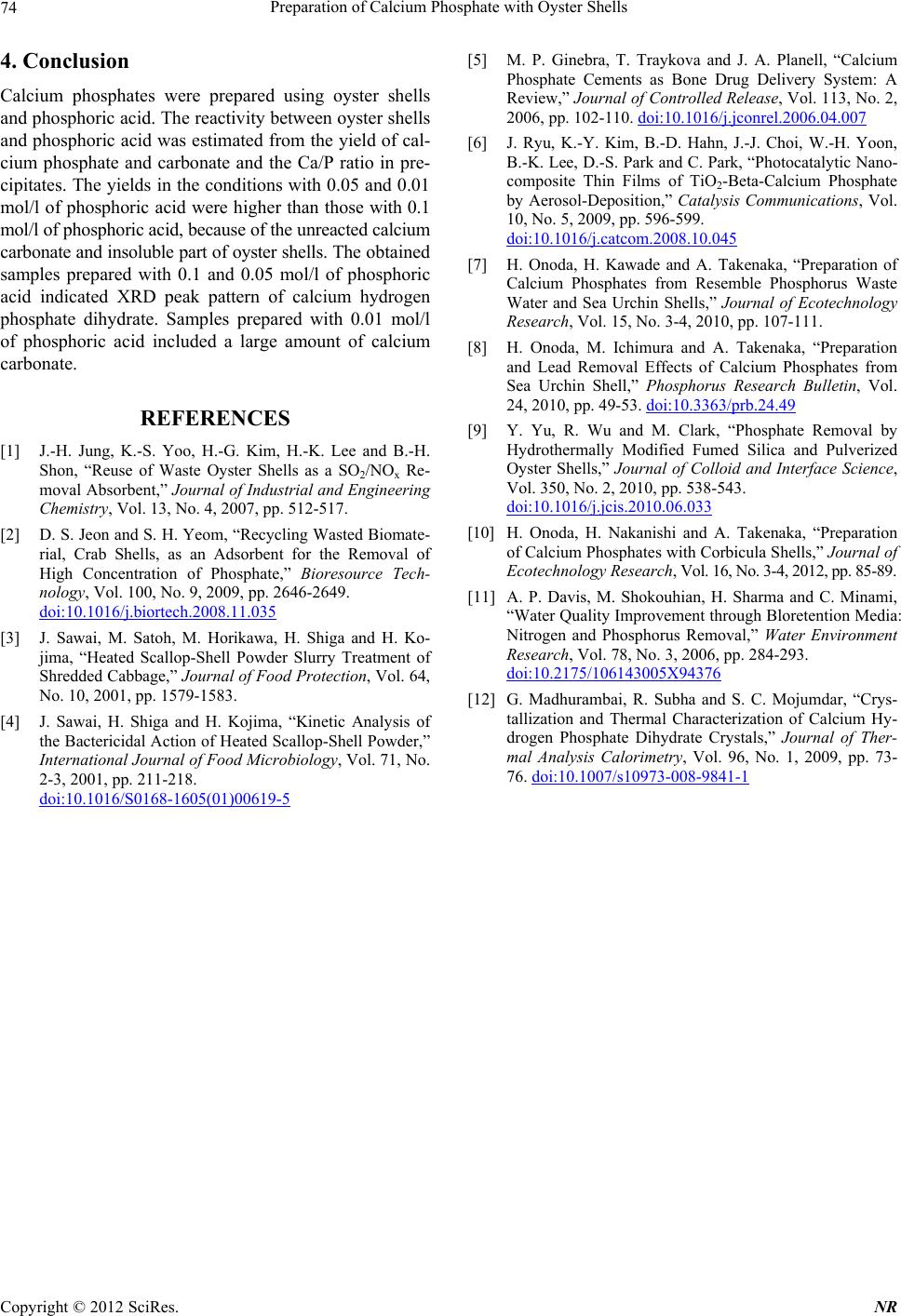
Preparation of Calcium Phosphate with Oyster Shells
74
4. Conclusion
Calcium phosphates were prepared using oyster shells
and phosphoric acid. The reactivity between oyster shells
and phosphoric acid was estimated from the yield of cal-
cium phosphate and carbonate and the Ca/P ratio in pre-
cipitates. The yields in the co nditions with 0.05 and 0.01
mol/l of phosphoric acid were higher than those with 0.1
mol/l of phosphoric acid, because of the unreacted calcium
carbonate and insoluble part of oyster shells. The obta in ed
samples prepared with 0.1 and 0.05 mol/l of phosphoric
acid indicated XRD peak pattern of calcium hydrogen
phosphate dihydrate. Samples prepared with 0.01 mol/l
of phosphoric acid included a large amount of calcium
carbonate.
REFERENCES
[1] J.-H. Jung, K.-S. Yoo, H.-G. Kim, H.-K. Lee and B.-H.
Shon, “Reuse of Waste Oyster Shells as a SO2/NOx Re-
moval Absorbent,” Journal of Industrial and Engineering
Chemistry, Vol. 13, No. 4, 2007, pp. 512-517.
[2] D. S. Jeon and S. H. Ye om, “Recycling Wast ed Biomate-
rial, Crab Shells, as an Adsorbent for the Removal of
High Concentration of Phosphate,” Bioresource Tech-
nology, Vol. 100, No. 9, 2009, pp. 2646-2649.
doi:10.1016/j.biortech.2008.11.035
[3] J. Sawai, M. Satoh, M. Horikawa, H. Shiga and H. Ko-
jima, “Heated Scallop-Shell Powder Slurry Treatment of
Shredded Cabbage,” Journal of Food Protection, Vol. 64,
No. 10, 2001, pp. 1579-1583.
[4] J. Sawai, H. Shiga and H. Kojima, “Kinetic Analysis of
the Bactericidal Action of Heated Scallop-Shell Powder,”
International Journal of Food Microbiology, Vol. 71, No.
2-3, 2001, pp. 211-218.
doi:10.1016/S0168-1605(01)00619-5
[5] M. P. Ginebra, T. Traykova and J. A. Planell, “Calcium
Phosphate Cements as Bone Drug Delivery System: A
Review,” Journal of Controlled Release, Vol. 113, No. 2,
2006, pp. 102-110. doi:10.1016/j.jconrel.2006.04.007
[6] J. Ryu, K.-Y. Kim, B.-D. Hahn, J.-J. Choi, W.-H. Yoon,
B.-K. Lee, D.-S. Park and C. Park, “Photocatalytic Nano-
composite Thin Films of TiO2-Beta-Calcium Phosphate
by Aerosol-Deposition,” Catalysis Communications, Vol.
10, No. 5, 2009, pp. 596-599.
doi:10.1016/j.catcom.2008.10.045
[7] H. Onoda, H. Kawade and A. Takenaka, “Preparation of
Calcium Phosphates from Resemble Phosphorus Waste
Water and Sea Urchin Shells,” Journal of Ecotechnology
Research, Vol. 15, No. 3-4, 2010, pp. 107-111.
[8] H. Onoda, M. Ichimura and A. Takenaka, “Preparation
and Lead Removal Effects of Calcium Phosphates from
Sea Urchin Shell,” Phosphorus Research Bulletin, Vol.
24, 2010, pp. 49-53. doi:10.3363/prb.24.49
[9] Y. Yu, R. Wu and M. Clark, “Phosphate Removal by
Hydrothermally Modified Fumed Silica and Pulverized
Oyster Shells,” Journal of Colloid and Interface Science,
Vol. 350, No. 2, 2010, pp. 538-543.
doi:10.1016/j.jcis.2010.06.033
[10] H. Onoda, H. Nakanishi and A. Takenaka, “Preparation
of Calcium Phosphates with Corbicula Shells,” Journal of
Ecotechnology Research, Vol. 16, No. 3-4, 2012, pp. 85-89.
[11] A. P. Davis, M. Shokouhian, H. Sharma and C. Minami,
“Water Quality Improvement through Bloretention Media:
Nitrogen and Phosphorus Removal,” Water Environment
Research, Vol. 78, No. 3, 2006, pp. 284-293.
doi:10.2175/106143005X94376
[12] G. Madhurambai, R. Subha and S. C. Mojumdar, “Crys-
tallization and Thermal Characterization of Calcium Hy-
drogen Phosphate Dihydrate Crystals,” Journal of Ther-
mal Analysis Calorimetry, Vol. 96, No. 1, 2009, pp. 73-
76. doi:10.1007/s10973-008-9841-1
Copyright © 2012 SciRes. NR